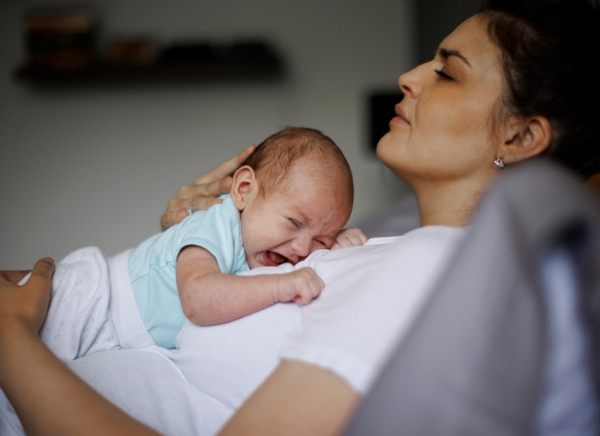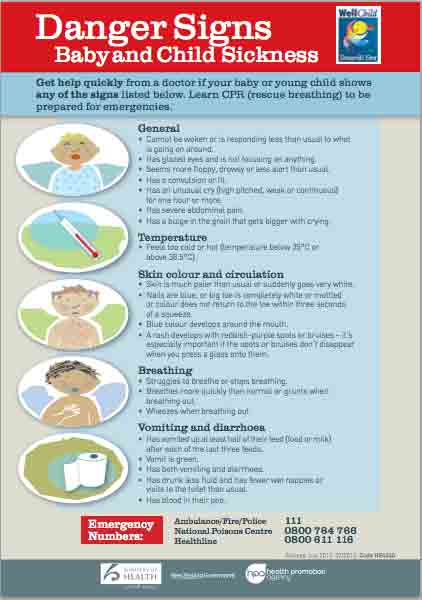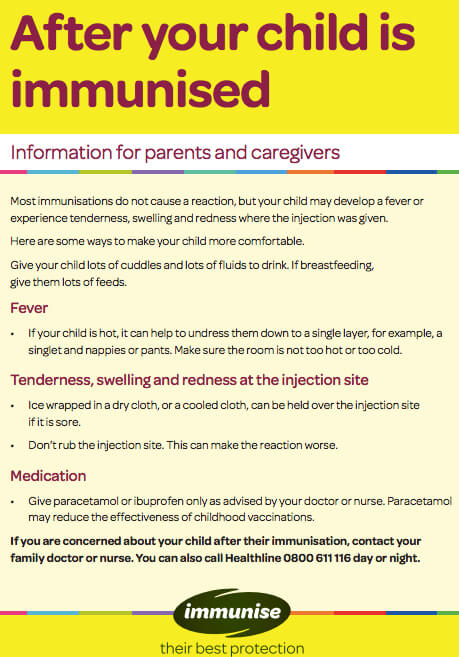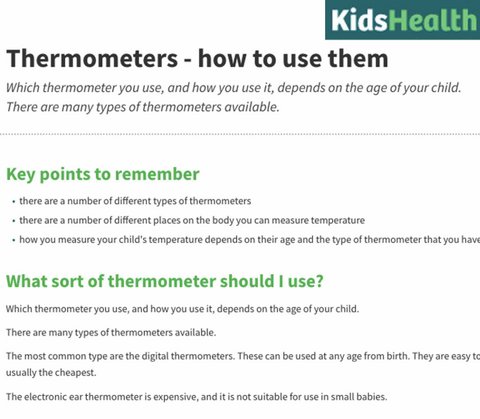Fever in children
Key points about fever in children
- A fever is a temperature over 38 degrees Celsius (38o C).
- A fever is usually caused by a virus, such as a cold. Fever is a normal way for a child to fight an infection.
- If your baby with a fever is under 3 months of age, always see a healthcare provider urgently.
- Fever by itself doesn't tell you whether your child is seriously sick.
- You know your child best. If you're worried at any stage, always seek help.
- The content on this page comes from KidsHealth(external link).

Fever is a normal way for a child to fight an infection
- Normal temperature – your child's normal body temperature is about 37 degrees Celsius (37o C).
- A fever – your child has a fever if their temperature is 38 degrees Celsius (38o C) or higher.
- A high fever – this usually means more than 38.5 degrees Celsius (38.5o C).
What the number on the thermometer can't tell you
Fever by itself doesn't tell you whether your child is seriously sick.
If your child is miserable and seems unwell, and feels hot, you can use a thermometer to take their temperature. You don't need to do this if your child seems well.
The number on the thermometer can't tell you:
- what's causing the fever
- how sick your child is.
Check how to use thermometers.
(KidsHealth, NZ, 2024)
Transcript
Fevers are common in tamariki.
They are usually caused by viruses.
A fever is a temperature of 38 degrees Celsius or higher.
Fever is a normal way for a child to fight an infection.
Pēpi under 3 months old with a fever need to see a health professional urgently.
If your child is miserable with a fever, you can give paracetamol to make them more comfortable.
Follow the instructions on the bottle.
Encourage your child to drink fluids.
You know your child best, if you are worried at any stage, always seek help.
Call Healthline on 0800 611 116 or take your child to a health professional if they have a fever and:
- are in pain or
- are taking less than half of their normal feeds or
- are vomiting or
- have frequent watery poo or
- you are worried
Take your child to a health professional urgently if your child has a fever and:
- is under 3 months old or
- looks unwell or
- is hard to wake or
- is not interested in surroundings or
- is having trouble breathing or
- is in severe pain or
- is upset by bright lights or
- is not drinking or
- is vomiting and not keeping fluids down or
- has a rash or
- you are worried
Call 111 if your child has a fever and:
- is floppy or
- is blue around the mouth or
- is struggling to breathe or
- is unresponsive or
- you are worried
Always go back to a health professional or call Healthline on 0800 611 116 if your child is getting worse or you are worried.
The most common cause of a fever in a child is a viral infection. Bacterial infections can also cause a fever.
Your body's natural reaction to infection with a virus or bacteria is to raise the temperature inside your body. This helps to kill the infection.
Other causes of fever include:
- vaccination
- wrapping a baby in too many warm layers of clothing, or bedding.
If you're worried about your child, whether or not there is a fever, take them to see a healthcare provider or call Healthline on 0800 611 116.
If your child has already seen a healthcare provider but they're getting worse, go back to a healthcare provider.
Call Healthline or see a healthcare provider
Call Healthline on 0800 611 116 or see a healthcare provider if your child with a fever:
- is drinking less than half of their normal feeds
- has less than half of their normal wet nappies
- has a sore throat
- is vomiting (being sick)
- has frequent and watery poo (diarrhoea)
- is in pain
- is getting sicker
- you're worried.
See a healthcare provider urgently
See a healthcare provider urgently if your child with a fever:
- is under 3 months old
- has an unusual high-pitched cry
- looks unwell
- is hard to wake
- is not interested in surroundings
- is having trouble breathing
- is in severe pain
- has a severe headache
- is upset by bright lights
- is not drinking
- is vomiting and not keeping fluids down
- has a rash
- you're worried
When should I call 111?Call 111 within Aotearoa New Zealand (use the appropriate emergency number in other countries) and ask for urgent medical help if your child:
|
If your baby is less than 3 months old and has a fever, take them to a healthcare provider urgently. |
- Pēpi get fevers for the same reason as older tamariki, but they're not as good at fighting off infections.
- If you're worried about them, take them to a healthcare provider even if they don't have a fever.

Image credit: Canva
You can look after your child with a fever at home if they:
- are drinking and feeding well
- are still interacting with you
- do not look sick.
Cooling cares
Undress your child so that they are just wearing a single layer (maybe a singlet and pants). Make sure the room is not too hot or too cold. These are the best and most comfortable ways to bring your child's temperature down. It's best not to give your child a bath or shower to cool them. You could use a cool face cloth.
Rest and fluids
Your child may need extra rest or they may want to play – this is okay.
Encourage your child to drink plenty of fluids. Offer then small amounts often. Your child may not feel like eating much. Their appetite will return as they start to get better.
Medicines
If your child is happy, and they are not unwell, you don't need to do anything more. You don't need to treat the fever with a medicine.
Paracetamol
If your child is miserable because of the fever, you can give paracetamol to make them more comfortable. You must follow the dosage instructions on the bottle. It's dangerous to give more than the recommended dose. You can use a paracetamol dose calculator to find out how much to give them.
Other medicine
If your healthcare provider gives your child ibuprofen, use it only if your child with a fever is miserable. You can use an ibuprofen dose calculator to find out how much to give them.
Don't give your child cold and flu medicines.
Never give your child aspirin as this may increase the risk of Reye syndrome, which is a rare and serious illness.
A small number of tamariki have seizures when they have fevers. Read more about febrile seizures.
Fever in children – does my child need medicine?(external link) Choosing Wisely, NZ
Temperatures and thermometers(external link) KidsHealth, NZ
Apps
Resources
Thermometers – how to use them(external link) KidsHealth, NZ
After your child is immunised(external link) HealthEd, NZ
Danger signs – baby and child sickness(external link) HealthEd, NZ
Do not routinely prescribe oral antibiotics to children with fever without an identified bacterial infection. The vast majority of children presenting with fever do not have a bacterial infection and therefore will not benefit from being prescribed oral antibiotics. For instance, one study of febrile infants found overall bacteraemia frequency of well below one per cent. Sometimes, in exception to this, oral antibiotics are prescribed to treat an unapparent bacterial infection or prevent development of severe bacterial infection and appear to have beneficial effects, though even the significance of these effects is disputed. Given that inappropriate prescribing of antibiotics is a major cause of antibiotic resistance and antibiotics have adverse effects, it is not considered good clinical practice to prescribe antibiotics in children without a specific bacterial infection. Paediatrics and child health(external link) Choosing Wisely, NZ, 2016
Identifying the risk of serious illness in children with fever(external link) BPAC, NZ, 2024
Fever – neutropenic(external link) Starship, NZ, 2014
Fever in under 2 month olds(external link) Starship, NZ, 2022
Fever in children(external link) Goodfellow Unit Webinar, NZ, 2021
Brochures

HealthEd, NZ, 2023 te reo Māori, English

HealthEd, NZ, 2023

KidsHealth, NZ, 2015
Credits: Content shared between HealthInfo Canterbury, KidsHealth and Healthify He Puna Waiora as part of a National Health Content Hub Collaborative.
Last reviewed:





